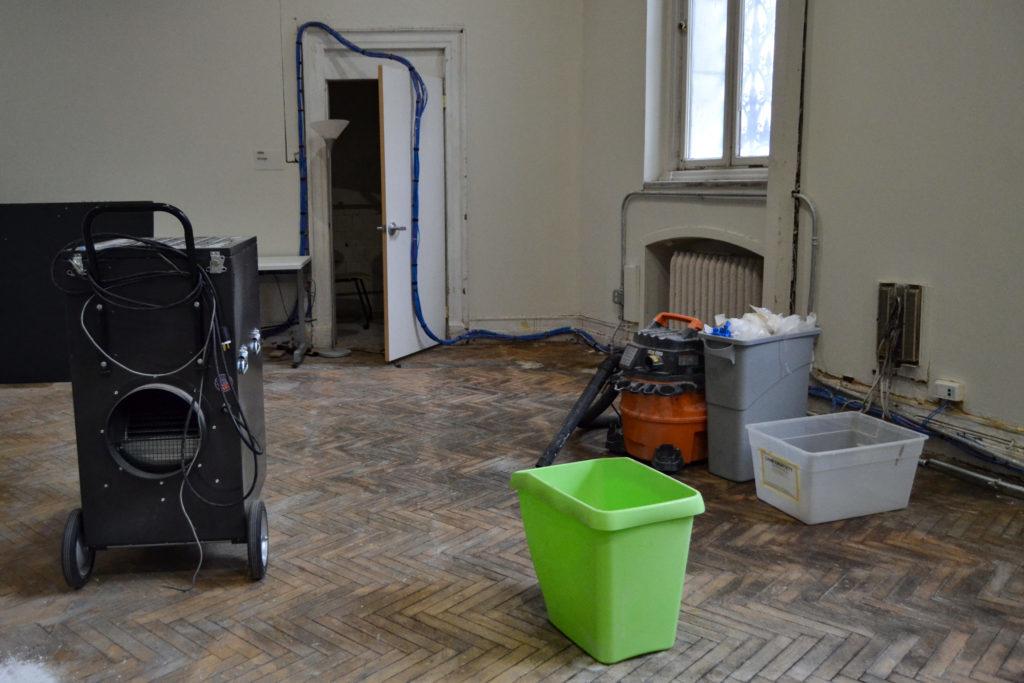The Flagg Building, which houses the Corcoran School of the Arts and Design, has continually experienced ceiling leaks since the beginning of the semester.
The second floor of the Flagg Building reopened at the beginning of the semester following two years of construction, but students and faculty said the building has since been plagued by water leaks.
University spokeswoman Maralee Csellar said “certain areas” of the Flagg Building have experienced leaks during the fall semester. She declined to specify which areas of the building experienced leaks.
She said officials completed the first phase of construction on the Flagg Building this summer and addressed “many long-standing” issues concerning areas of the roof, ceiling and envelope leaks. She said when a leak is reported, the University works “rapidly” to assess the situation and partners with contractors to address the issues with a particular leak.
“The University is working to prioritize additional roof and envelope work in the building to occur and will be further considering this work as part of the upcoming capital budget process,” she said.
Csellar said given the “record-setting” levels of rain this fall, the building experienced leaks and needed repairs that were “not anticipated” in the short term. She added that the roof and envelope repairs completed during the first phase of construction have not created additional leaks and have helped reduce the number that would have occurred if not for the renovations last year.
“When unexpected maintenance issues happen, we realize that established routines for how students spend their day getting to and from class, work or internships can be a disruption,” she said. “We apologize for the inconvenience while we work to repair this damage.”
University President Thomas LeBlanc said at a Faculty Senate meeting in September that the University was “assured” that the money spent on the roof over the past two years would “maintain a functional building” for at least five years. LeBlanc said he budgeted more money for the roof after “experts” said a complete replacement would be necessary to fix leakage problems.
“At my request, they put extra money into the roof,” LeBlanc said at the meeting. “They did more of the roof than they were going to do because I was worried about exactly that, and even with that extra money, we still had a rainstorm that leaked.”
Harald Griesshammer, a member of the Faculty Senate and an associate professor of theoretical nuclear and particle physics, said at the same meeting that part of the roof only had tarp over it, resulting in leaks that destroyed computer equipment.
“Now not only do we have to repair the roof, but we also have to replace the computer equipment so it’s another great opportunity for GW to be pennywise and not foolish,” he said.
Lena Ghannam, an adjunct professorial lecturer of interior architecture, said she is aware of a leak in Room 218 in the Flagg Building and said it should be addressed to ensure the water does not interfere with classes and learning.
“Construction and renovation on historically preserved buildings are tremendously complex,” Ghannam said. “I believe that revisions to address any lingering issues are ongoing.”
Jordan Jackson, a first-year graduate student in the interior architecture program, said the leak in Room 218 has continued throughout the entire semester, preventing students from using two tables as workspaces. She added that because the room is used to work and store materials, there is always a chance that a student may leave their work overnight and return to find it damaged by water.
“When those two tables aren’t usable because of the leak, it just makes us all crowd in more or some of us have to work in a different room, which I think inhibits our creative process because we can’t all communicate,” Jackson said.
Sydney Meister, a senior majoring in interior architecture, said the leaks have caused a class to relocate to a different room and, on one occasion, the class had to meet in the same room as another section.
“The leak was present every time it rained,” Meister said. “The first time, we combined the classes, and the occurrences of the leak after that, I guess whoever we had complained to put trash cans on the desk to catch the water, and we were told that we had to stay in the classroom.”
Michelai Lowe, a first-year graduate student in the interior architecture program, said her professors are aware of the problem. She added that her department is “really good” about responding to complaints, but the leak has not yet been fixed.
“We all spend a lot of money to come here and outside our tuition and fees and our supplies,” Lowe said. “We spend a lot of money to be sitting in a classroom with leaks.”




